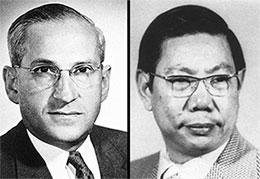Treatment of Solid Tumor Cancers with the Chemotherapy Drug Methotrexate
Key Points
- Prior to the 1950s, treatment for the majority of cancers was limited to either surgery or the use of radiation.
- By successfully curing a rare tumor called gestational choriocarcinoma (or GC) with the use of a chemotherapy drug called methotrexate, researchers at the National Cancer Institute (NCI) paved the way for treatment of solid tumors with chemotherapy.
- This marked the first time a cancer had been cured and led to the development of many of today's common cancer treatments.
Pathway to Discovery
Folate, a nutrient in the vitamin B complex, is vital in the production and maintenance of new cells, especially in infants and during pregnancy. This is when cells are dividing and growing rapidly. In 1949, Sidney Farber, M.D., a pathologist and clinician, speculated that because cancer cells divide rapidly, they need folate to support the rapid cell growth. He also thought that taking a drug that is a folate inhibitor, such as methotrexate, would slow the progress of cancer. By giving methotrexate to children with acute lymphoblastic leukemia (ALL), a fast-growing type of blood cancer, Farber saw an improvement in the children's symptoms. However, methotrexate achieved only short-term ALL remission, until combination chemotherapy was attempted in 1970.
Roy Hertz, M.D., began his career at the National Institutes of Health (NIH) studying the effect of folic acid on the female urogenital tract, the organ system of the reproductive organs and the urinary system. In 1946, Dr. Hertz became chair of the Endocrinology Section at the National Cancer Institute (NCI). His previous research on the effects of various compounds on the female urogenital tract led him to study the effect of antifolate treatments, such as methotrexate, on rapidly dividing cells of the reproductive tract—specifically, the placenta.
While Hertz was exploring the effects of antifolates on the female urogenital tract and their potential use in treating adrenal cancer, Min C. Li, Ph.D., had attempted antifolate therapy in patients with metastatic melanoma. Though success remained elusive, Li did note a dramatic decrease in urinary human chorionic gonadotropin (β-HCG) with antifolate treatment. While β-HCG is more commonly known as a marker of pregnancy in healthy women, it has also been associated with multiple tumors, including trophoblastic and testicular tumors, melanomas, and carcinomas of the breast, gastrointestinal tract, lung, and ovaries.
Perseverance makes a treatment breakthrough. When Hertz learned of Li's results with melanoma, he speculated that methotrexate might be an ideal treatment for a cancer specific to the female reproductive tract called gestational choriocarcinoma. GC occurs in the uterus when cells that would normally have become the placenta suddenly grow abnormally. Before methotrexate, GC was nearly always fatal. Thinking that the growth of GC could at least be slowed through the use of methotrexate, Hertz recruited Dr. Li to NCI and together they studied the use of methotrexate in patients with metastatic GC. To their surprise, the tumors responded, shrinking dramatically. This was the first time a solid tumor had ever responded to chemotherapy treatment.
Enhancing Cancer Care
In 1956, Hertz and Li published their landmark findings on methotrexate treatment. This article was the first to document radiographic regression of tumor metastases based on chemotherapy treatment. Another publication in 1958 by Hertz et al. described how 27 patients who suffered from choriocarcinoma and related diseases responded to treatment. Five patients achieved a complete cure. By 1962, the previously fatal GC had a cure rate of 80 percent. Today, cancer centers that specialize in the care of patients with GC have close to 100 percent cure rates in patients where the disease has not metastasized.
Alan Rabson, M.D., Deputy Director of NCI, described Dr. Hertz as having had "a major impact on cancer therapy. Showing that it wasn't only leukemia that was curable with chemotherapy was a pivotal step. It opened up the rest of the field." In 1972, Drs. Hertz and Li were awarded the prestigious Lasker Award—often considered to be the "American Nobel prize"— for their groundbreaking work.
With the first significant success against solid cancer tumors, the medical field was turned on its head. Previous assumptions that cancer was nearly always fatal were revised, and the field of medical oncology (treatment of cancer with chemotherapy), which had not previously existed, was formally established in 1971. The findings that a chemotherapy drug could send cancer into long-term remission gave renewed hope that other cancers could be successfully treated in a similar way.
The 1960s and 1970s brought significant advances in chemotherapy as researchers addressed the ongoing challenges of cancer treatment. The Clinical Center at NIH was central to many of the early breakthroughs in chemotherapy. By 1970, Hodgkin lymphoma (a cancer of the immune system) was viewed as a curable disease and Wilm's tumor (a cancer of the kidney that typically occurs in young children) had responded to a combination of radiation and chemotherapy. These discoveries paved the way for future advances in chemotherapy.
Turning Discovery into Health
In the 1950s and 1960s, the use of methotrexate was just beginning to be explored. It would soon prove useful in treating breast cancer, head and neck cancer, and osteogenic sarcoma (a bone cancer), either alone or in combination with other chemotherapy drugs.
The field of medical oncology exploded in the 1960s and 1970s, bringing triumphs to the world of cancer treatment by curing Hodgkin lymphoma. Combination chemotherapy would change the face of cancer treatment.
The current incidence (the number of new cases diagnosed each year) of GC remains at 1 in 20,000 pregnancies in the United States. In some developing nations, however, the incidence is as high as 1 in 2,000 pregnancies. With proper detection and treatment, GC is now a curable disease.
Research to Practice: NCI's Role
In 1953, NCI created a clinical research center in the new Clinical Center at NIH where chemotherapy drugs were given to patients while maintaining high standards of medicine in an experimental setting. NCI funding supported Drs. Hertz and Li, along with many of the scientists at the forefront of chemotherapy development in the 1960s and 1970s.
Key Takeaway
Prior to the 1950s, treatment for the majority of cancers was limited to either surgery or the use of radiation. The discovery that methotrexate could successfully cure a rare cancerous tumor paved the way for treatment of solid tumors with chemotherapy. With NCI support, this led to the development of many of today's common and successful cancer chemotherapy treatments across a range of cancer types.
Selected Resources
Hertz RB, Bergenstal DM, Lipsett MB, Price EB, Hilbish TF. Chemotherapy of choriocarcinoma and related trophoblastic tumors in women.J Am Med Assoc. 1958; 168(7):845-854.
Lewis JL, Jr. Choriocarcinoma: A success story for chemotherapy. Int J Radiat Oncol Biol Phys. 1980;6(7):897-898. [PubMed]
Li MC, Hertz R, Spencer DB. Effect of methotrexate therapy upon choriocarcinoma and chorioadenoma. Proc Soc Exp Biol Med. 1956;93(2):361-366. [PubMed]
Oranksy I. Roy Hertz. Lancet. 2002;7(360):1893.
Yarris JP, Hunter AJ. Roy Hertz, M.D. (1909-2002): The cure of choriocarcinoma and its impact on the development of chemotherapy for cancer. Gynecol Oncol. 2003;89(2):193-198. [PubMed Abstract]

